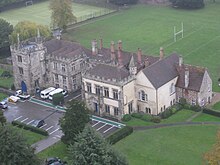Salisbury Cathedral School
 |
|
| Motto | Domine dilexi decorem domus tuae |
|---|---|
| Established | 1091 |
| Type |
Independent preparatory day and boarding school Choral foundation school |
| Religion | Church of England |
| Headmaster | Mr Clive Marriott |
| Chair of Governors | Robert Key, former MP of Salisbury |
| Founder | Saint Osmund |
| Location |
1 The Close Salisbury Wiltshire SP1 2EQ England Coordinates: 51°03′50″N 1°47′45″W / 51.063777°N 1.795966°W |
| DfE number | 865/6022 |
| DfE URN | 126518 Tables |
| Staff | 38 |
| Students | 250 |
| Gender | Mixed |
| Ages | 3–13 |
| Houses | 4 |
| Website | www |
Salisbury Cathedral School is a co-educational independent school located in Salisbury, Wiltshire, England. It was founded in 1091 by Saint Osmund at Old Sarum.
The school was founded by Saint Osmund, the Bishop of Old Sarum and Earl of Dorset, who was recognized for his good works when he was canonised several hundred years later in 1456. Osmund was born in Normandy and was a first cousin of William the Conqueror, King of England: William's father, Robert the Magnificent, Duke of Normandy, was the brother of Isabella, Countess of Séez, the mother of Osmund.
The first notable pupil of the school was John of Salisbury who served Archbishop Thomas Becket until the latter was murdered in 1170. John was quoted by Queen Eleanor of Aquitaine.
Originally, the School would have been housed near to the Cathedral at Old Sarum. At the start of the 13th.Century the centre of the Diocese of Salisbury was moved from Old Sarum to its present site. The choristers would then have lodged with various canons in the new Cathedral Close. After 1319, a house was built in The Close to house the School (known as 'The Choristers' House'). The School remained here for the next 300 years. The choristers were educated in the Chancellor's Grammar School nearby.
In 1714, the School moved to a new School House built for it on the north-west side of The Close. This came to known as 'Wren Hall' and, with the house connected to it (Braybrooke House) this acted as the centre of the School campus until the middle of the 20th.Century. Owing to the fact that this campus could not keep pace with the growing size of the School, the campus was relocated, in 1946/47, to the former Bishop's Palace in the grounds of the Cathedral. The building is designated as a Grade I listed building by English Heritage.
...
Wikipedia
